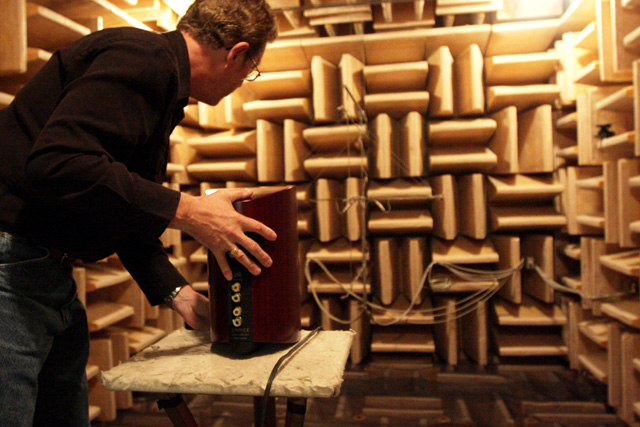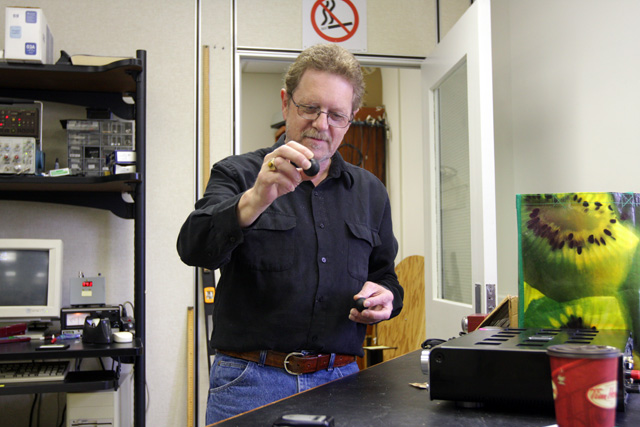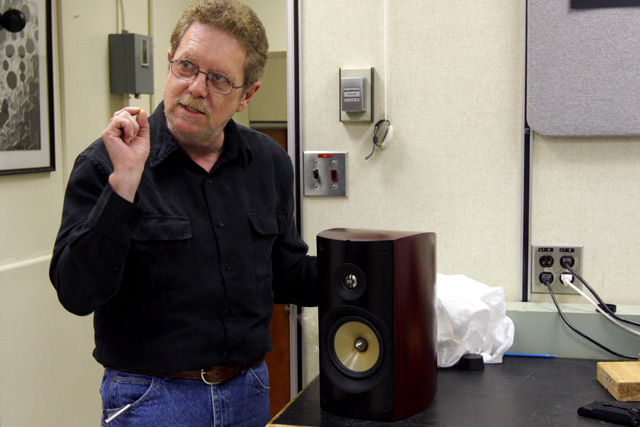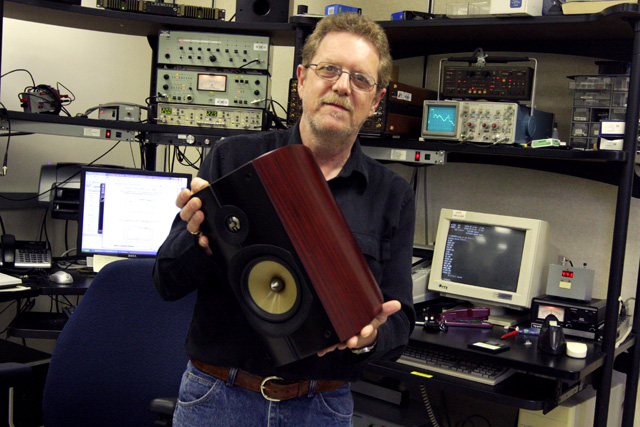November 1, 2008Performance by
Design: Paul Barton and PSB Speakers
It’s been said that loudspeaker design is
as much art as science, but I’m not at all sure that’s true. Over the past year
I’ve spent many hours at Canada’s National Research Council (NRC), watching and
listening as Paul Barton developed a new series of loudspeakers. Based on that experience,
I’d argue that the proportions are nowhere near 50/50; they’re more like 98%
science and 2% art.
Paul Barton, founder and chief designer of PSB Speakers, is
widely respected as being one of the top speaker designers in the world today. He has been
at the forefront of speaker design since the 1970s, when he was an acolyte of the
legendary Dr. Floyd Toole, who literally wrote the book on the science of loudspeaker
design: Sound Reproduction: The Acoustics and Psychoacoustics of Loudspeakers and Rooms
(Focal Press, 2008). Toole’s work at the NRC paved the way for Canada’s
flourishing loudspeaker industry and led directly to the founding of such prominent
manufacturers as Paradigm, Axiom, and, of course, PSB. He was the first researcher to
apply to loudspeaker design the rigors of the scientific method by designing
scientifically valid blind-testing methodologies, correlating them with measured
performance, and publishing his results in peer-reviewed journals.
After leaving the NRC, Floyd Toole headed research at
Harman International; he is now retired, but the fruits of his labors live on in listening
rooms around the world. The lab he founded at the NRC is still active today, and 10 to 12
times a year it’s where you’ll find Paul Barton and his van full of prototype
speakers, drivers, and crossovers.
It’s a drive of four or five hours from PSB’s
headquarters in Pickering, in southern Ontario, to the NRC facility in Ottawa -- I asked
Barton why he continues making the trip when he could easily build his own anechoic
chamber and lab. His answer was part nostalgia and part familiarity. First, he said, he
enjoys coming back to the place where his loudspeaker journey first took flight three
decades ago. The very control room he uses today was the site of numerous design
breakthroughs, not to mention creative exchanges among the top minds of the loudspeaker
world. For Barton, the walls of this room resonate with creative energy. Nor does it hurt
that the NRC lab is chock-full of proven instruments that he can probably use with his
eyes closed. In sum, the NRC is home for Barton; when he’s working on a speaker
design, there’s no other place he wants to be.

Every speaker Paul Barton has designed in the last 30
years has gone through rigorous testing in the anechoic chamber at Canada’s National
Research Council.
|
During my most recent visit to the NRC, on a
Saturday afternoon in September, Barton was double-checking samples from the first full
production run of PSB’s new Imagine loudspeaker series. I was there to pick up a pair
of Imagine B stand-mount speakers for review -- over the past year, I’ve watched the
development of the Imagine series, from rough boxes fitted with prototype drivers through
unfinished engineering samples and, finally, fully fledged retail products.
I hope that, after more than 30 years of working in my own
field, that I’ll still be as enthusiastic about it as Barton is about his. Despite
the fact that NRC lab time doesn’t come cheap, it wasn’t at all unusual for
Barton to take an hour to explain to me the fine points of selecting materials for driver
cones, or the importance of choosing the right rubber compound for a driver’s
surround. He even carries a pair of rubber balls in his travel bag to demonstrate the
importance of the surround in damping cone resonances.
As we all know from Isaac Newton, every action has an equal
and opposite reaction. The action here is the mechanical vibration induced in the driver
cone by the voice-coil. This action originates at the center of the cone and propagates
outward, toward the cone’s edge. When the vibration reaches the edge of the cone,
physics demands that it reverse direction (the reaction) and return to the center of the
cone. It’s the surround’s job to prevent that from happening: if the
out-of-phase (opposite) energy were allowed to return to the cone, it would severely
affect the driver’s output.
To illustrate that there’s more to designing a driver
surround than meets the eye, Barton showed Soundstage! Network publisher Doug
Schneider and me two rubber balls, equal in size and nearly identical in appearance. He
held one ball about two feet above a table, announced that it was made of regular rubber,
and let go. The ball hit the table and rebounded about two-thirds of the distance it had
fallen, before again descending. Over several seconds of bouncing the ball lost its
kinetic energy (as heat) and finally came to rest.
The second ball had a slightly dull sheen in comparison to
the first, but otherwise looked and felt the same. Barton dropped it onto the table from
the same height he’d dropped the first ball. However, when this second ball struck
the table, it rebounded only about an inch, and came to a complete rest on only its second
impact. "This ball," Barton told us, "is made from the surround material we
use. It has a compound added to it which is much more efficient at transforming kinetic
energy into heat. That" -- he pointed to the second ball -- "is good surround
material."
Of course, there’s more to the development of a driver
surround than what it’s made of. The trick is to develop a compound that dissipates
energy -- in other words, is "lossy" -- without making it so lossy that
the cone’s action becomes sluggish. As someone who’d thought the surround was
merely the outermost part of the cone’s suspension, I found this lesson fascinating.

Paul Barton uses two identical-looking but very
different rubber balls to illustrate his point about loudspeaker surrounds.
|
During that September visit, we were
accompanied by another talented speaker designer who had wanted to meet Barton. To hear
the two of them talk about design philosophies was fascinating, if sometimes a little hard
to follow. What impressed me was when the visiting engineer showed Barton an anechoic
measurement of one of his own designs. Noticing a peak in the midbass distortion, Barton
not only correctly diagnosed the problem, he offered a solution that, it turned out, the
other engineer had already found to be the cure -- all after looking at a single
measurement for only a few seconds. I hope that all heart surgeons are so talented at
reading instruments and graphs.
Clearly, Paul Barton works at a level far beyond trial and
error design; he knows what he wants from a speaker, and he knows how to go about getting
it. That was illustrated by the critically acclaimed and innovative Synchrony series.
Though other speaker makers may confine their best
technologies to their top-line products, Barton and PSB believe that innovations developed
for one line should, as much as possible, be shared with the others. The Imagine, for
example, benefits from work he did on PSB’s acclaimed Synchrony series, and
there’s an obvious familial resemblance. The profiles of the cabinets are similar,
and the Synchronys’ aluminum front baffles provided design inspiration for the
Imagines’ sculpted front. But while the two series may look similar in many ways,
some of the Synchrony design elements were simply too expensive to include in the
lower-priced Imagine.
PSB broke new ground with the Synchrony cabinet in using
side panels of multilayer MDF that lock into place with the front and back panels of
extruded aluminum. This technique has now been used for the Imagine series, though the
latters’ all-MDF cabinets aren’t quite as sophisticated as the Synchronys’.
To make an Imagine panel, a heavy-duty industrial press molds seven layers of MDF into
shape while simultaneously zapping them with high-energy radio frequencies. This has the
effect of microwaving the glue between the layers and transforming the entire assembly
into a single dense mass of great rigidity.

Paul Barton explains the intricacies of the Imagine
series’ cabinet construction.
|
While a glance at the shapes of an Imagine
speaker’s front, top, and bottom panels might lead one to assume that they’re
made the same way as the sides, they’re instead carved by a massive, custom-designed
sanding machine. Blocks of MDF are attached to the front, top, and bottom of each speaker,
and are then sanded down in place until the proper profile is achieved. By the time an
Imagine cabinet is ready to have its driver and binding-post holes and ports cut, there
isn’t a flat surface to be found on it. That makes it tricky to get the cabinet lined
up in the giant milling machine that makes these cuts, but engineering know-how,
tight-tolerance jigs, and lasers ensure that the cuts are made in exactly the right spots.
The Imagine’s woofer is an all-new design. Its
earth-tone color indicates that its composite cone has an inner layer of vapor-deposited
ceramic, which increases the rigidity of the cone while allowing it to remain very
lightweight. The phase plug at the center of the woofer benefits from extensive testing
done by Barton to find the perfect shape, size, and material for the Synchronys’
phase plug. The Imagines’ titanium-dome tweeter uses a voice-coil different from that
found in the Synchrony models, but its overall design was informed by work done during the
Synchrony tweeter’s development.
The Synchrony and Imagine series both have large rubber
gaskets around the perimeter of their drivers. In the Synchronys, this serves to bridge
the gap between the drivers (which are mounted on an inner baffle) and the front panel,
which is mechanically isolated from the driver mounts. The Imagines’ drivers,
however, are more conventionally mounted, in this case to a thick baffle of multilayer
MDF. The Imagines’ gasket serves a largely cosmetic function, effectively hiding the
drivers’ mounting hardware and giving the front baffle a clean look similar to that
of the Synchronys. Barton beamed when discussing the rear panel’s rubber trim, its
sculpted design flowing from the binding posts at the bottom to the driver port at the
top. "Look at how tight this fit is!" he exclaimed. "It took a lot of work
to get these shapes to come together, because the curvature of the cabinet and the rubber
piece has to be exactly right or you’ll see gaps between them." Sure enough, the
fit was as tight as that of an Apple iPod. It looked great, too.
The Imagine models are available finished in cherry or
black ash, and, like the Synchronys, the real-wood veneers are beautifully applied. Two
aspects of the Imagines’ finish of which Barton is particularly proud are the
matching of veneers between speaker pairs, and the fact that the "cathedral"
pattern in each piece of veneer (i.e., the center of the veneer sheet has an
inverted-V pattern reminiscent of a church steeple) is centered on the sides and top of
each speaker. If there’s a cathedral on each side of the speaker, that means that the
seams of two pieces of veneer must meet on the speaker’s rear panel; indeed they do,
but if you can see a seam anywhere on an Imagine, you’ve got better eyes than mine.
The quality of the veneer work is spectacular for a speaker at any price, and remarkable
considering the Imagine B’s retail price of $1000 USD per pair.

Paul Barton presents the production Imagine B, another
design developed at the lab of Canada’s National Research Council.
|
The real tests of Paul Barton’s -- or
anyone’s -- speaker designs take place on showroom floors and in consumers’
homes. But before a PSB speaker ever gets to the production phase, Barton must be
completely happy with it. He measures, measures, and measures again, each time quantifying
a design’s progress until he sees results that he knows will be pleasing to the ear.
That might not sound very romantic, but it’s the truth. Good speaker design
can’t be faked, but it can be measured -- and, as Paul Barton and PSB Speakers have
proven again and again, it can be repeated. Look for my review of the PSB Imagine B here
at GoodSound! on November 15; we’ll see how all his measurements have
translated into real-world performance.
. . . Colin Smith
|